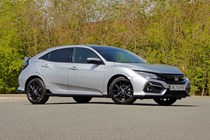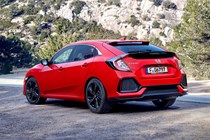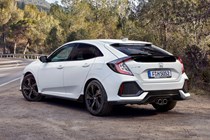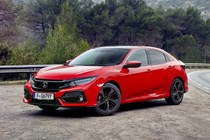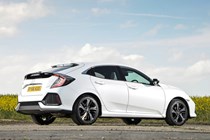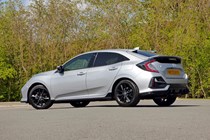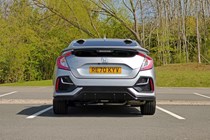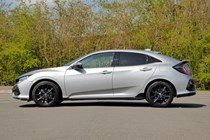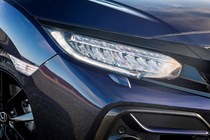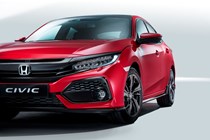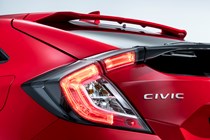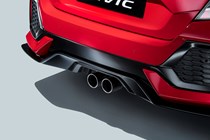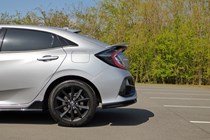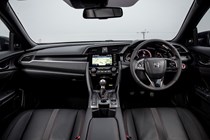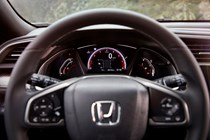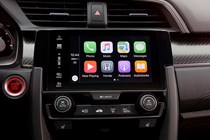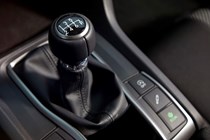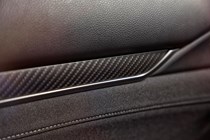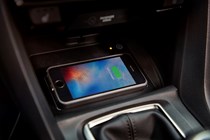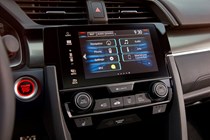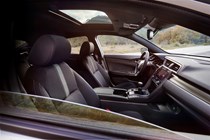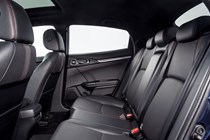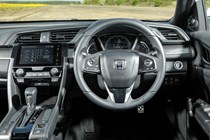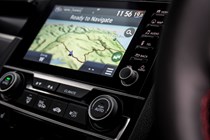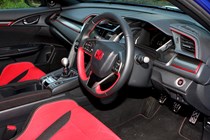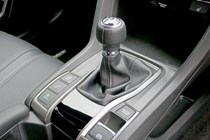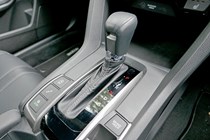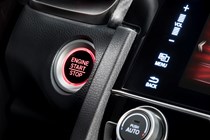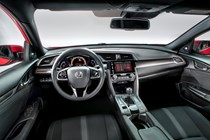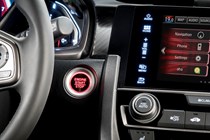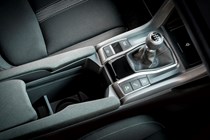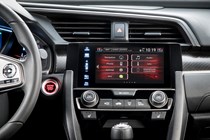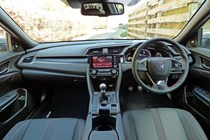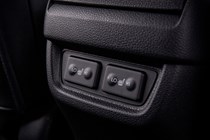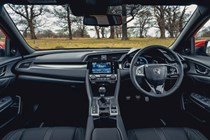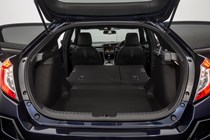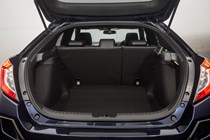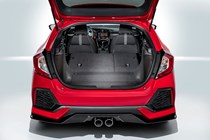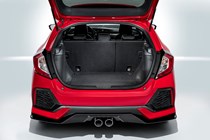
Honda Civic Hatchback (2017-2022) interior, tech and comfort
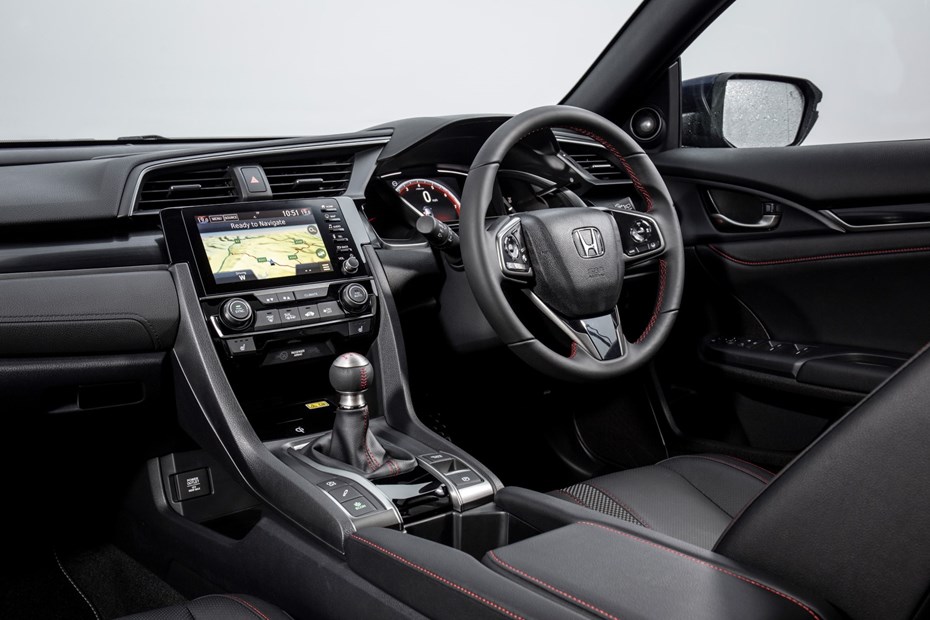
- Plenty of adjustability in steering wheel and seat
- Clear instrument display punctuated by large digital speedo
- Let down by poor quality of steering wheel buttons
How is the quality and layout?
The Mk10 Civic’s interior is a mixed bag, but benefits from getting the fundamentals absolutely spot on.
The driving position is wonderful, with lots of adjustment allowing you to set it nice and low down for a sporty feel or more high up and perched for a commanding view out – more akin to the more upright Civics of old.
There’s also plenty of movement in the steering wheel, while the seat moves backwards a lot further than some rivals. Drivers of all shapes and sizes should be able to find a comfortable position in the Civic. However, there’s no denying that the low-slung Civic isn’t as easy to get into and out of as its predecessor.
As for the rest of the dashboard, it’s solid and well built with high-quality materials but lacks the last degree of finesse and polish you’d find in rivals such as a Volkswagen Golf. The buttons on the steering wheel, for example, are plasticky and confusing, while the leather and other materials don’t feel quite as dense and premium as they could.
Sportier models come with red stitching, while EX Sport Line comes with a metal-topped gearknob.
Infotainment and tech
As standard, all cars get a digital dial pack. This could be compared to the likes of Audi’s Virtual Cockpit, but the reality is quite different. While some rivals offer many different possible instrument layouts, Honda opts for just one – trading customisability for clarity.
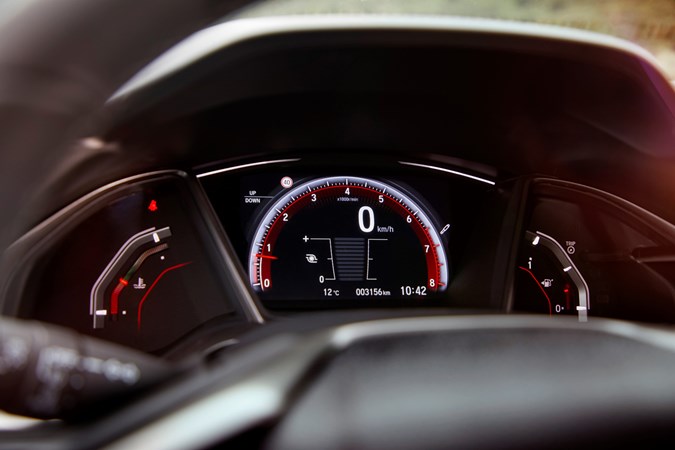
We love the large, digital speedometer and crescent moon rev counter above it – it’s a very clear pairing and easy to read at a glance. The centre portion of the screen can show everything from fuel economy to safety information, and Honda’s also the first manufacturer we’ve seen to pull navigation directions from a paired smartphone to display in the instrument panel, giving a degree of coherence even if you’ve eschewed the built-in navigation for Apple CarPlay or Android Auto.
The Civic uses a 7.0-inch infotainment display which actually runs the mobile operating system Android. You might think this makes it just like a smartphone to operate, but unfortunately the reverse is true.
The infotainment system is poor by the standards of the class. It’s clunky to use, looks dated, and feels as though it’s a third-party system shoehorned in rather than a genuine manufacturer part. The menu system could be better organised and the icons are all over the place from page to page.
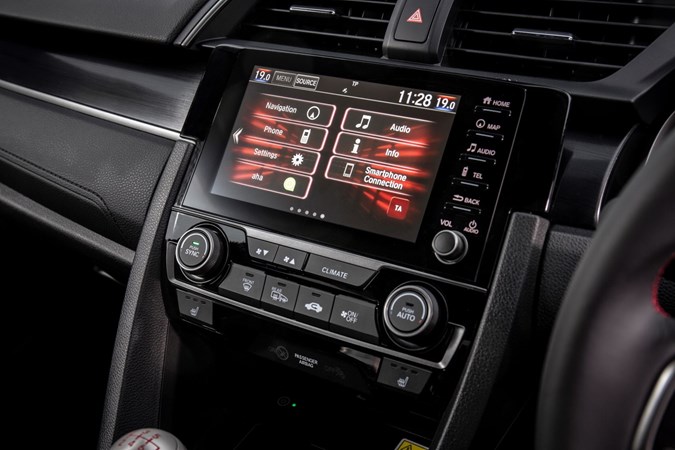
The saving grace is that Apple CarPlay and Android Auto both come as standard, so it’s totally possible to bypass the Honda system in favour of using smartphone integration.
Until the 2019 facelift, the infotainment screen had touch-sensitive hot keys and a volume scroller, but after feedback from customers and motoring publications these were replaced by proper buttons and a twisty volume knob. A big improvement for day-to-day use.
Comfort
- Refinement could be better
- Rear seat headroom good, but not great
- Good ride comfort
The Honda Civic is a comfortable car to live with. It’s at the slightly softer end of the scale in its class in terms of ride quality but it’s very well controlled, preventing the Civic from wallowing about or pitching too much as a consequence.
Bumps are well isolated from the cabin, while EX-spec cars feature a two-setting Adaptive Damper System which adjusts the firmness of the Civic’s suspension. It’s a nice idea, but works best when left in Comfort mode as the jittery ride in Dynamic provides little benefit to the Civic’s handling.
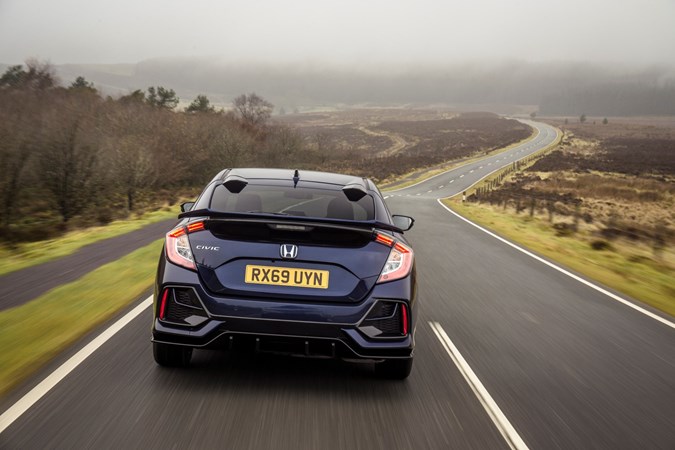
What we’d wish for in the Civic is a little more sound deadening and a little less vibration filtering into the cabin, as this takes an element of polish away from the Honda’s overall comfort, especially in comparison with the Volkswagen Golf.
The 1.0-litre turbo can become quite vocal at higher revs when demanding more from the engine and becomes a particular issue with the CVT automatic, which has a tendency to keep revs higher than necessary. There’s also quite a lot of vibration from the three-cylinder engine felt through the seats and steering wheel, although both these traits do improve on the motorway. It’s also worth noting this is less of an issue on the two larger engines.
What is a constant companion is the amount of high frequency road noise resonating in the cabin. The 11 speaker stereo on top spec models is just about punchy enough to overcome the noise, but it does have a battle on its hands.
Thankfully there’s very little road roar to deafen you, but you’ll notice the stark difference in volume between the best and worst road surfaces. There’s also a little wind noise fluttering around the front windows as well.
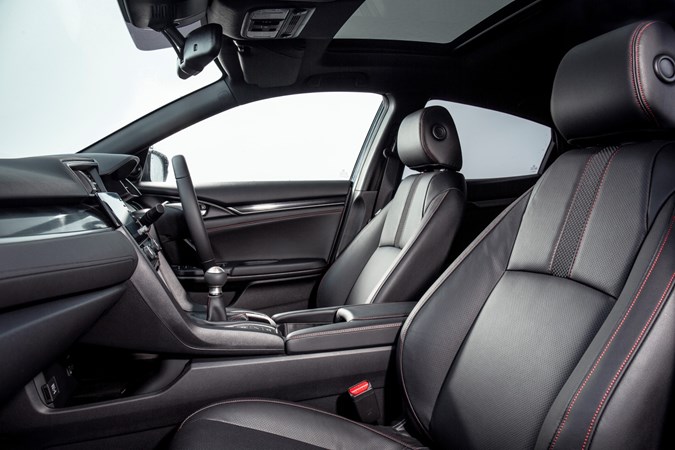
When it comes to seat comfort, the driving position will feel a little odd coming straight out of an older Civic, and sitting lower means there’s a loss of front visibility, especially around the bulky A-pillars.
The firm driver’s seat is well shaped and offers plenty of adjustment and support – there doesn’t appear to be much side bolstering, but we haven’t found it to be a noticeable problem.
Those sat in the rear will be treated to plenty of legroom and a well-shaped rear bench. It loses out to the Golf and Ford Focus in terms of rear headroom, though, which is a concern for growing families.


